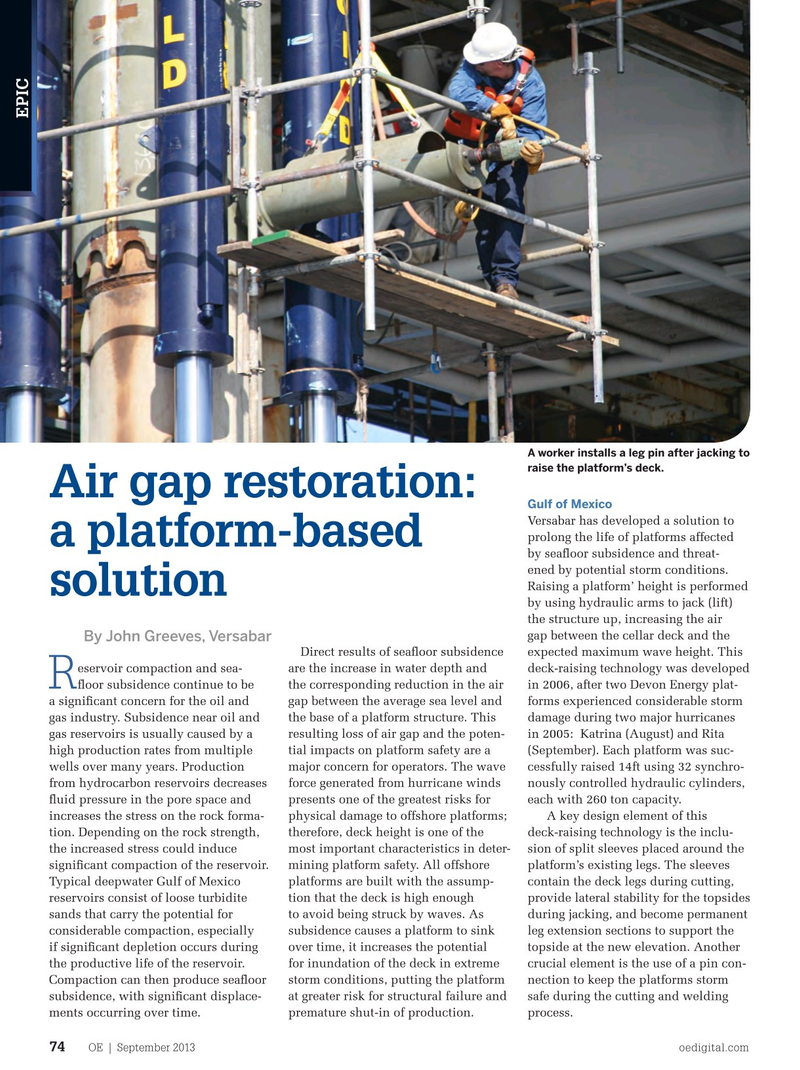
Page 72: of Offshore Engineer Magazine (Sep/Oct 2013)
Read this page in Pdf, Flash or Html5 edition of Sep/Oct 2013 Offshore Engineer Magazine
EPIC
A worker installs a leg pin after jacking to raise the platform’s deck.
Air gap restoration:
Gulf of Mexico
Versabar has developed a solution to prolong the life of platforms affected a platform-based by seafoor subsidence and threat- ened by potential storm conditions.
Raising a platform’ height is performed solution by using hydraulic arms to jack (lift) the structure up, increasing the air gap between the cellar deck and the
By John Greeves, Versabar
Direct results of seafoor subsidence expected maximum wave height. This eservoir compaction and sea- are the increase in water depth and deck-raising technology was developed foor subsidence continue to be the corresponding reduction in the air in 2006, after two Devon Energy plat-
R a signifcant concern for the oil and gap between the average sea level and forms experienced considerable storm gas industry. Subsidence near oil and the base of a platform structure. This damage during two major hurricanes gas reservoirs is usually caused by a resulting loss of air gap and the poten- in 2005: Katrina (August) and Rita high production rates from multiple tial impacts on platform safety are a (September). Each platform was suc- wells over many years. Production major concern for operators. The wave cessfully raised 14ft using 32 synchro- from hydrocarbon reservoirs decreases force generated from hurricane winds nously controlled hydraulic cylinders, fuid pressure in the pore space and presents one of the greatest risks for each with 260 ton capacity. increases the stress on the rock forma- physical damage to offshore platforms; A key design element of this tion. Depending on the rock strength, therefore, deck height is one of the deck-raising technology is the inclu- the increased stress could induce most important characteristics in deter- sion of split sleeves placed around the signifcant compaction of the reservoir. mining platform safety. All offshore platform’s existing legs. The sleeves
Typical deepwater Gulf of Mexico platforms are built with the assump- contain the deck legs during cutting, reservoirs consist of loose turbidite tion that the deck is high enough provide lateral stability for the topsides sands that carry the potential for to avoid being struck by waves. As during jacking, and become permanent considerable compaction, especially subsidence causes a platform to sink leg extension sections to support the if signifcant depletion occurs during over time, it increases the potential topside at the new elevation. Another the productive life of the reservoir. for inundation of the deck in extreme crucial element is the use of a pin con-
Compaction can then produce seafoor storm conditions, putting the platform nection to keep the platforms storm subsidence, with signifcant displace- at greater risk for structural failure and safe during the cutting and welding ments occurring over time. premature shut-in of production. process.
OE | September 2013 oedigital.com 74 000_OE0913_EPIC2_platforms.indd 74 8/18/13 8:35 PM

 71
71

 73
73